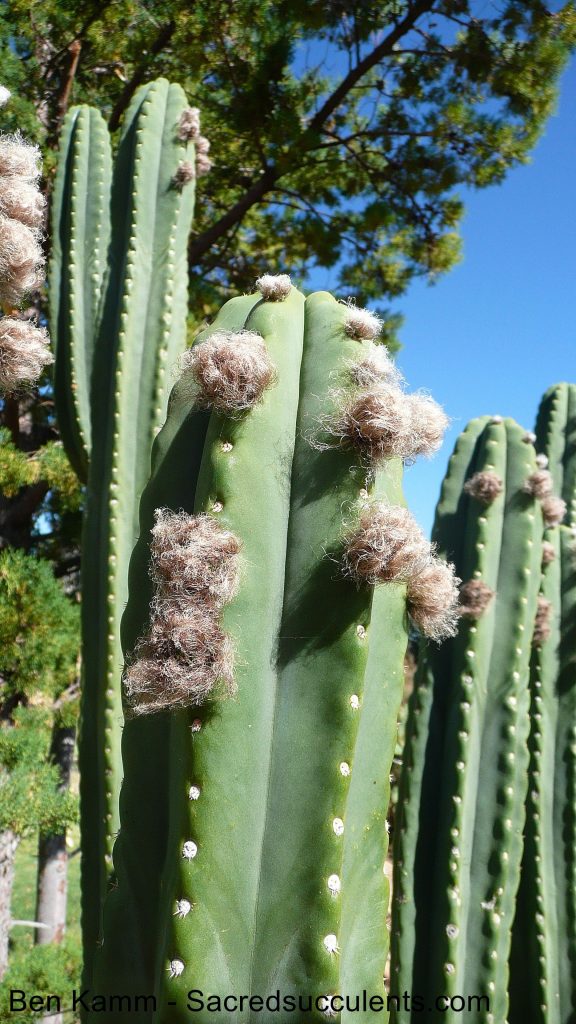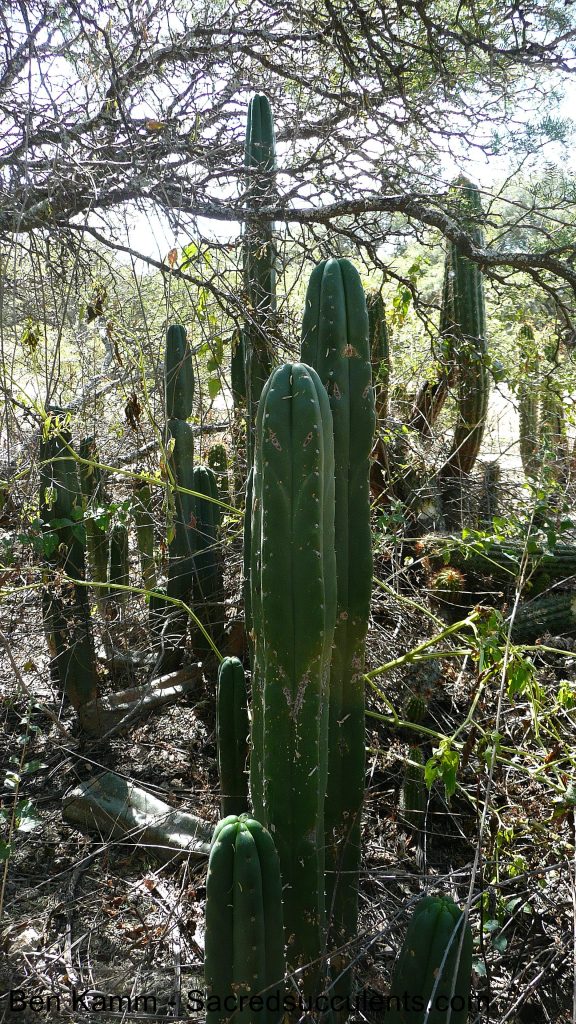Does Echinopsis pachanoi grow in Bolivia?
There are many mentions of Echinopsis pachanoi cactus in Bolivia. But much unlike popular belief, most of those plants are actually spineless varieties of Trichocereus bridgesii. Though both species can be very similar under certain conditions, you definitely see the difference on flowering plants. Echinopsis pachanoi often has brown or black hairs on the flowers, while the hairs on the Bolivian species are often white. This is not always the case, but sometimes.
Here are some of the Bolivian Trichocereus populations that were visited during Sacred Succulents´Field Trips. Most of the plants are labeled Trichocereus aff. pachanoi, what stands for „affinity to Trichocereus pachanoi“. That means that those plants look similar to Trichocereus pachanoi, while they probably are more closely related to Trichocereus bridgesii. Don´t forget that Echinopsis pachanoi is widely cultivated in every South American country today. It´s just that the Bolivian version of it is Trichocereus bridgesii. It is sometimes called Cactus of the four winds. The latter has become a catchy marketing phrase for everything that has four ribs, but that has more to do with marketing than ancient history. Nonetheless, this phrase has been used for a four-ribbed Bridgesii type. With that said, many plants can temporarily have four ribs, but usually grow some later on.
Here I will show some photos from the Sacred Succulents Field Trips from Bolivia. All those pics are from Ben Kamm and Sacredsucculents.com. Please support them to make more Field Trips like those possible!
Check out the full article with photos here: Echinopsis pachanoi in Bolivia
BK10512.11 Trichocereus aff. pachanoi, near Cuchucunata, Cochabamba, Bolivia
Those plants are relatively spineless, but look pretty typical for Bolivian plants between Trichocereus pachanoi and Trichocereus bridgesii. In my eyes, those are just spineless or relatively spineless forms of Trichocereus bridgesii but you would need to take a look at the flowers to verify. There certainly are some cultivated Pachanois in Bolivia, but they are grown as natural fencing or garden plants are did not evolve over time. Most populations of the San Pedro cactus in Bolivia are actually Trichocereus bridgesii.
Trichocereus aff. pachanoi, Arani, Cochabamba, Bolivia
On this one, you can see the obvious relationship to Trichocereus bridgesii. I originally wrote that it might be related to Trichocereus scopulicola, but it could as well but just another type of Trichocereus bridgesii. But the labeling with aff. pachanoi fits pretty good, though those are all closer related to Trichocereus bridgesii than they are to Trichocereus pachanoi.
BK10508.5 T. aff. pachanoi, Tiatako, Cochabamba, Bolivia
Another version of the San Pedro cactus in Bolivia. This one is the most interesting, because it might actually be a relative of Trichocereus scopulicola. But I would need to take a closer look at the rest of the plants. On the second pic, the ribs look very much like the ribs on a Trichocereus scopulicola.
BK10508.1 Trichocereus aff. pachanoi, Cerro San Pedro, Cochabamba, Bolivia 2010
Trichocereus bridgesii, Martin Cardenas Botanical Garden, Cochabamba, Bolivia 2010
Trichocereus aff. pachanoi, Martin Cardenas Botanical Garden Cochabamba, Bolivia 2010
Very cool Trichocereus growing in Martin Cardenas Botanical Garden in Cochabamba, Bolivia!
Trichocereus species in Martin Cardenas Botanical Garden Cochabamba, Bolivia
Martin Cardenas is a specialist on peruvian cacti and this is his botanical garden in Chochabamba. He is widely accepted and respected field botanist and it´s really great to see his private garden.




Keine Kommentare:
Kommentar veröffentlichen